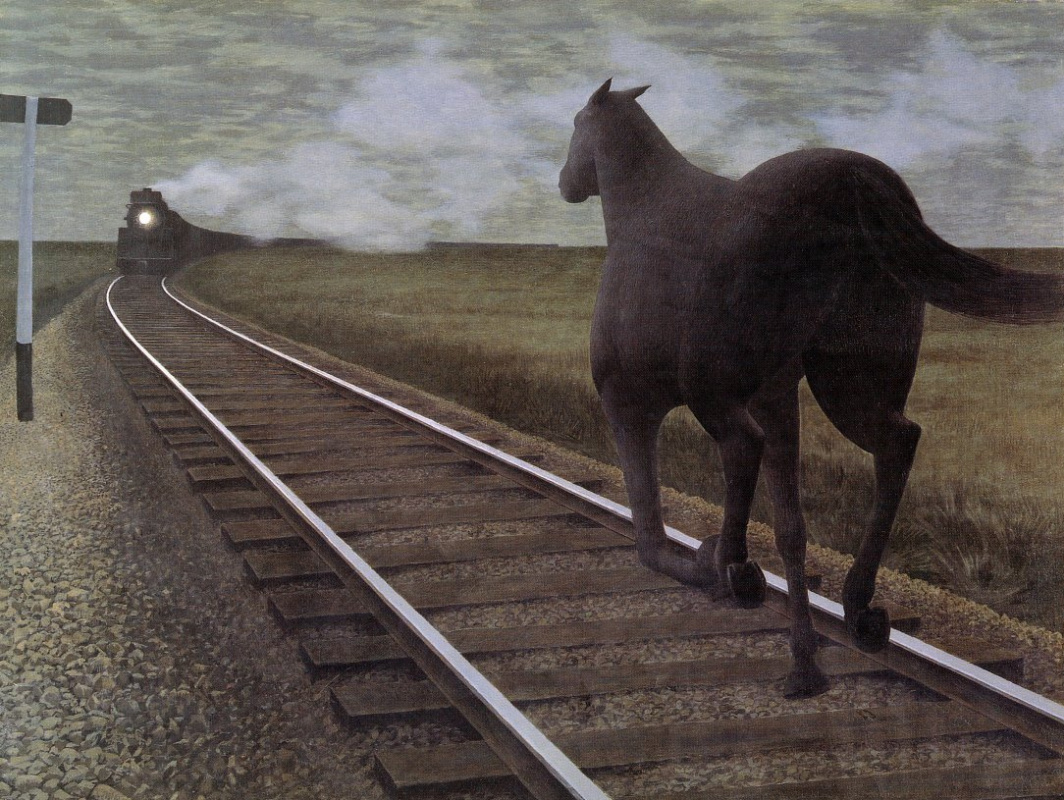log in
Enter site
Login to use Arthive functionality to the maximum
Horse and train
Alex Colville • Painting, 1954, 40×53.3 cm
Description of the artwork «Horse and train»
The painting "Horse and train" by Alex Colville-inspired lines from the poem "Dedication to Mary Campbell" the South African poet Roy Campbell: "Against a regiment I nominate your brain. And a dark horse against an armored train".
This painting, like many of Colville's work, imbued with a sense of impending disaster, but it significantly differs from them. If the other paintings of the artist is a vague sense of threat somewhere on the periphery while peaceful at first glance, the plot, it is obvious that the tragedy is inevitable. Due to the lack of shadows and distorted perspectives is not entirely clear whether the horse depicted in full gallop, whether in the time of the fall. But in any case in the terrible outcome of this collision leaves no doubt.
In 1957, Colville wrote a letter to the Director of the Art gallery of Hamilton, which purchased the painting: "I always thought that the picture is very good. But realized that very few would dare to buy it to hang on the wall of his house (it seems that most people find it extremely gloomy)".
This work is in a sense very personal for the artist, since he spent his childhood among the horses owned by his father and grandfather. In addition, the Colville childhood was fond of constructing models of airplanes and trains. Many critics believe that the artist, "pushing the horse against the train" sets and the viewer, and himself the fundamental question: is it possible to change destiny? In 1950-ies with the help of his work in Coalville began to indulge in existential reflection on human existence and responsibility for their own lives. Thus he tried to regain the lost during the Second World war, the peace of mind. The artist believed that evil may unexpectedly intervene in the lives of everyone and change the course of history.
Author: Eugene Sidelnikov
This painting, like many of Colville's work, imbued with a sense of impending disaster, but it significantly differs from them. If the other paintings of the artist is a vague sense of threat somewhere on the periphery while peaceful at first glance, the plot, it is obvious that the tragedy is inevitable. Due to the lack of shadows and distorted perspectives is not entirely clear whether the horse depicted in full gallop, whether in the time of the fall. But in any case in the terrible outcome of this collision leaves no doubt.
In 1957, Colville wrote a letter to the Director of the Art gallery of Hamilton, which purchased the painting: "I always thought that the picture is very good. But realized that very few would dare to buy it to hang on the wall of his house (it seems that most people find it extremely gloomy)".
This work is in a sense very personal for the artist, since he spent his childhood among the horses owned by his father and grandfather. In addition, the Colville childhood was fond of constructing models of airplanes and trains. Many critics believe that the artist, "pushing the horse against the train" sets and the viewer, and himself the fundamental question: is it possible to change destiny? In 1950-ies with the help of his work in Coalville began to indulge in existential reflection on human existence and responsibility for their own lives. Thus he tried to regain the lost during the Second World war, the peace of mind. The artist believed that evil may unexpectedly intervene in the lives of everyone and change the course of history.
Author: Eugene Sidelnikov


